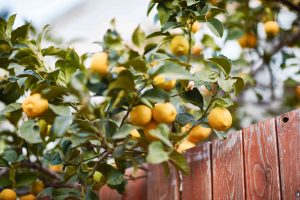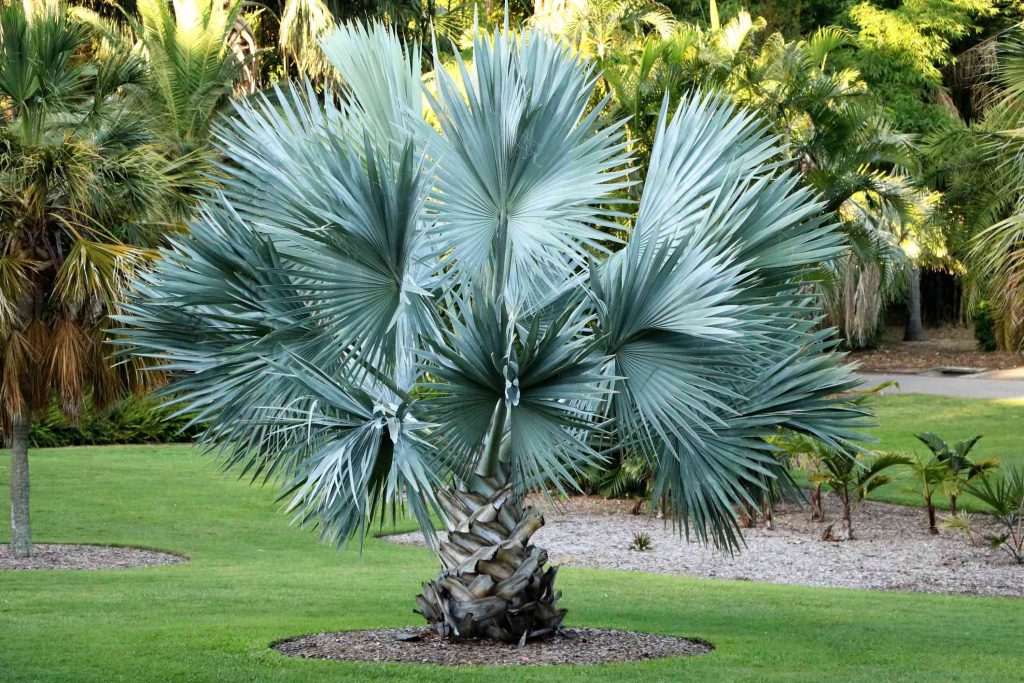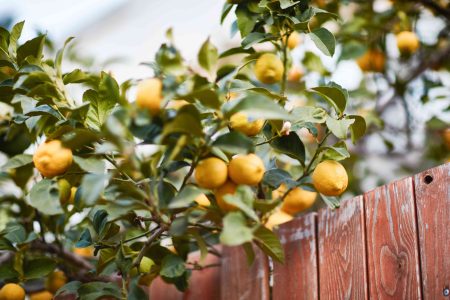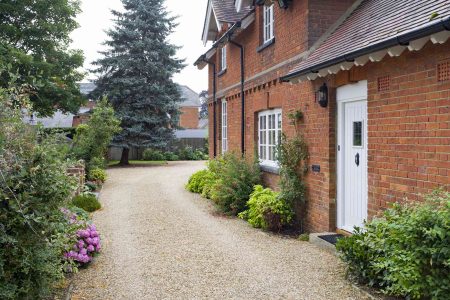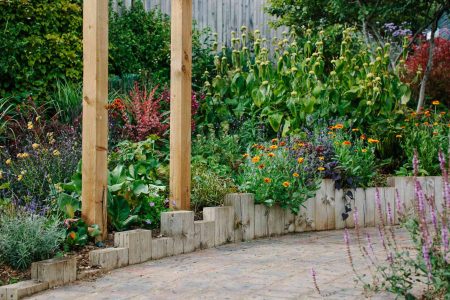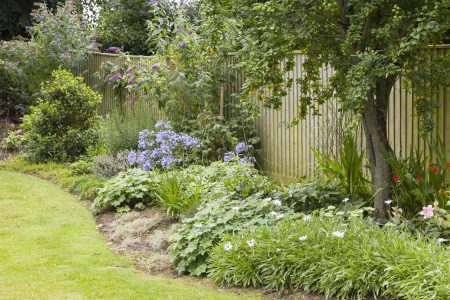We usually associate palm trees with beachfront homes, exotic island locales, or large coastal cities in places like Florida or Georgia. But palm trees can also be a unique part of your home landscape. Some palm trees grow as tall as 60 feet, but there are a number of varieties that are much smaller.
If you want to plant a small palm tree in your yard, there are a number of them that grow to a manageable height, from three feet to 25 feet, and many heights in between. Palm trees have fronds (leaves) that come in three shapes: feather (pinnate and bipinnate), fan, and entire.
Here are our favorite small palm trees in a variety of sizes—there’s something for every space.
-
01
of 17Bottle Palm
The bottle palm, also known as “palmiste gargoulette” is native to south Florida, is named for its unique trunk shape that resembles a tall soda bottle. It has graceful feather fronds and usually only puts out four to six of them per year. The tree grows slowly and rarely gets taller than 10 feet. It is also very salt tolerant, making it a great specimen for oceanside locations.
- Name: Bottle Palm (Hyophorbe lagenicaulis)
- Mature Size: 8 to 10 ft. tall
- Light: Full to part sun
- USDA Hardiness Zone: 10a to 10b
- Drought Tolerance: Fairly drought tolerant, though regular watering is optimal
-
02
of 17Pygmy Date Palm
Pygmy date palms (Phoenix roebelenii) are also known as miniature date palms or robellini palms. These humidity-loving plants are native to southeast Asia and the “dates” they produce are small black seed pod clusters that turn dark red when ripe enough to eat. They have a handsome form with a spreading crown of fronds at the top of the tree.
- Name: Pygmy date palm (Phoenix roebelenii)
- Mature Size: 6 to 12 ft. tall
- Light: Full to partial sun
- USDA Hardiness Zone: 9a to 11b
- Drought Tolerance: somewhat drought tolerant, soil should not be allowed to dry out completely
-
03
of 17Sago Palm
The sago palm, also known as the king palm, is a long-lived, slow-growing small tree native to Asia. It is not technically a palm and is more accurately described as a conifer, but has the appearance of a palm tree. The plant is toxic to humans and pets, so care should be taken in its placement.
- Name: Sago palm (Cycas revoluta)
- Mature Size: 3 to 10 ft. tall
- Light: Full to partial sun
- USDA Hardiness Zone: 9 to 10
- Drought Tolerance: Likes regular watering but is somewhat drought tolerant
-
04
of 17Parlor Palm
The petite, easy care parlor palm is often grown as a houseplant, but does well when grown outdoors in suitable tropical climate conditions. Native to Mexico and Central America, it tends to grow clumps of multiple stems as opposed to having a central trunk. The glossy, dark green fronds are popular for floral arrangements due to the cut stem’s ability to stay vibrant for weeks in water.
- Name: Parlor palm (Chamaedorea elegans)
- Mature Size: 6 to 16 ft. tall
- Light: Partial sun
- USDA Hardiness Zone: 10 to 12
- Drought Tolerance: Drought tolerant; avoid overwatering
Continue to 5 of 17 below -
05
of 17Spindle Palm
A spindle palm is somewhat slow-growing, and the shape of its trunk is similar to the bottle palm when both trees are younger. The fountain like crown of fronds has an elegant look. The plant’s Greek name means “pig food.”
- Name: Spindle palm (Hyophorbe verschaffeltii)
- Mature Size: 20 to 25 ft. tall
- Light: Full sun
- USDA Hardiness Zone: 10a to 11 (more cold tolerant with maturity)
- Drought Tolerance: Drought tolerant once established
-
06
of 17Windmill Palm
The windmill palm—also known as Chusan Palm, hemp palm, Nepalese fan palm, and Chinese windmill palm—has large, light green fan-shaped fronds that grow from the tree’s crown. Native to Asia, it is fairly cold hardy for a palm and can grow in both temperate and tropical zones, and is commonly grown in Europe and the United States. Though it can grow up to 40 feet in height, it usually averages between 10 and 20 feet, making it a suitable specimen for a good-sized home garden.
- Name: Windmill palm (Trachycarpus fortunei)
- Mature Size: Up to 40 ft. tall, but average height is 10 to 20 ft. tall
- Light: Part sun to part shade
- USDA Hardiness Zone: 8a to 11
- Drought Tolerance: Becomes more drought tolerant with maturity
-
07
of 17Cat Palm
The small cat palm tree is commonly grown as a house plant. It has graceful slender fronds that cascade from the crown (hence its other name of cascade palm), and will reach up to eight feet tall outdoors. It bears stalks of tiny yellow flowers in late winter to early spring.
- Name: Cat palm (Chamaedorea cataractarum)
- Mature Size: 6 to 8 ft. tall
- Light: Partial sun
- USDA Hardiness Zone: 9 to 11
- Drought Tolerance: Drought tolerant, avoid overwatering
-
08
of 17Pindo Palm
The pindo palm is native to Brazil, and is suitable for warm coastal regions. This tree has a rounded squat trunk and striking silvery blue-green fronds. It is often called jelly palm due to the small sweet golden yellow fruits it produces in abundance, commonly used to make jelly. It is salt tolerant and grows well in poor soils.
- Name: Pindo palm (Butia capitata)
- Mature Size: 15 to 20 ft. tall
- Light: Full sun
- USDA Hardiness Zone: 8 to 11
- Drought Tolerance: Somewhat drought tolerant, avoid overwatering
Continue to 9 of 17 below -
09
of 17Saw Palmetto
This dwarf palm is a great choice for compact spaces, topping out at a maximum height of 10 feet. The name comes from the sharp teeth-like edges of the fronds. It is somewhat cold hardy, salt tolerant, and can be grown in temperate areas. The tree produces small fragrant flowers and attracts bees who make a tasty, highly prized honey from its nectar.
- Name: Saw palmetto (Serenoa repens)
- Mature Size: 3 to 10 ft. tall
- Light: Full to partial sun
- USDA Hardiness Zone: 8 to 11
- Drought Tolerance: Very drought tolerant once established
-
10
of 17Foxtail Palm
The elegant foxtail palm can grow from 10 to 30 feet tall outdoors, with a wide canopy full of fluffy fronds that can spread up to 20 feet. For gardeners with ample space in warm zones, this is a beautiful ornamental tree. Note that the seeds are toxic if ingested and it is recommended that the seed pods be removed before ripening if possible. The foxtail palm is somewhat slow growing and takes about 20 years to reach full maturity.
- Name: Foxtail palm (Wodyetia bifurcata)
- Mature Size: 10 to 30 ft. tall
- Light: Full to partial sun
- USDA Hardiness Zone: 10 to 11
- Drought Tolerance: Relatively drought tolerant once established
-
11
of 17Lady Palm
The lovely, long-lived lady palm is native to southeast Asia. Also called broadleaf palm and bamboo palm, it’s a palm that can be grown indoors but also makes for a good small palm tree in a garden in warmer climates. The multiple trunks are topped with round clusters of spiky, glossy, dark green leaves, giving this small palm a somewhat unique look. Younger specimens are often grown in containers, though the mature trees eventually get up to 15 feet wide.
- Name: Lady palm (Rhapis excelsa)
- Mature Size: 5 to 15 ft. tall
- Light: Full to partial sun
- USDA Hardiness Zone: 9a to 11a
- Drought Tolerance: Drought tolerant once established
-
12
of 17Blue Latan Palm
For a unique color scheme, the blue latan palm can’t be beat for its silvery blue fans of leaves and pale silvery trunk. It tolerates poor and salty soil conditions. This showy tree is often planted in high visibility locations such as along driveways or near entryways.
- Name: Blue latan palm (Latania loddigesii)
- Mature Size: 20 to 25 ft. tall
- Light: Full sun to part shade
- USDA Hardiness Zone: 10 to 11
- Drought Tolerance: Very drought tolerant once established
Continue to 13 of 17 below -
13
of 17Areca Palm
The areca palm is native to Madagascar and can grow up to 30 feet tall (averaging 15 to 20 feet in height when cultivated), with a wide crown that may span 20 feet at maturity. This plant is sometimes called bamboo palm due to its delicate yellow-green leaves that grown in dense clusters and resemble bamboo leaves.
- Name: Areca palm (Dypsis lutescens)
- Mature Size: 20 to 30 ft. tall
- Light: Full to partial sun
- USDA Hardiness Zone: 10 to 11
- Drought Tolerance: Drought tolerant, avoid overwatering
-
14
of 17Needle Palm
Needle palms are one of the most cold hardy of the smaller palm trees, native to the southeast of the United States. Named for its slender needle-like foliage in shades of pale silvery green, this palm grows in a shrub-like form and is suitable for a corner location in the garden.
- Name: Needle palm (Rhapidophyllum hystrix)
- Mature Size: 3 to 6 ft. tall
- Light: Full to partial sun
- USDA Hardiness Zone: 6 to 10
- Drought Tolerance: Very drought tolerant once established
-
15
of 17Dwarf Palmetto
This beautiful shrub produces round fans of strappy gray-green leaves. Small white flowers attractive to pollinators are followed by long clusters of black fruits that attract birds and wildlife. The dwarf palmetto is fairly cold hardy and not fussy about soil.
- Name: Dwarf palmetto (Sabal minor)
- Mature Size: 5 to 10 ft. tall
- Light: Full to partial sun
- USDA Hardiness Zone: 8 to 11
- Drought Tolerance: Drought tolerant once established
-
16
of 17European Fan Palm
The European fan palm, also known as Mediterranean fan palm, is a small palm tree that grows in temperate and tropical climates. It can have either a single trunk or multiple trunks. The blue-green fronds are glossy and elegant, and the tree produces small orange fruits that are inedible.
- Name: European fan palm (Chamaerops humilis)
- Mature Size: 6 to 15 ft. tall
- Light: Full to partial sun
- USDA Hardiness Zone: 8 to 11
- Drought Tolerance: Moderately drought tolerant once established
Continue to 17 of 17 below -
17
of 17Puerto Rican Thatch Palm
Also known as silver thatch palm, this attractive palm tree has silvery fronds and produces small dark purple fruits. On average it grows between 20 to 25 feet tall when cultivated though can sometimes grow taller in its native habitats. The “thatch” in its common names refers to the trunk’s coarse overlapping texture. Native to Puerto Rico and the Virgin Islands, it is tolerant of poor and salt soils.
- Name: Puerto Rican thatch palm (Coccothrinax barbadensis)
- Mature Size: 20 to 25 ft. tall
- Light: Full sun
- USDA Hardiness Zone: 10a to 10b
- Drought Tolerance: Very drought tolerant once established
Read the full article here




